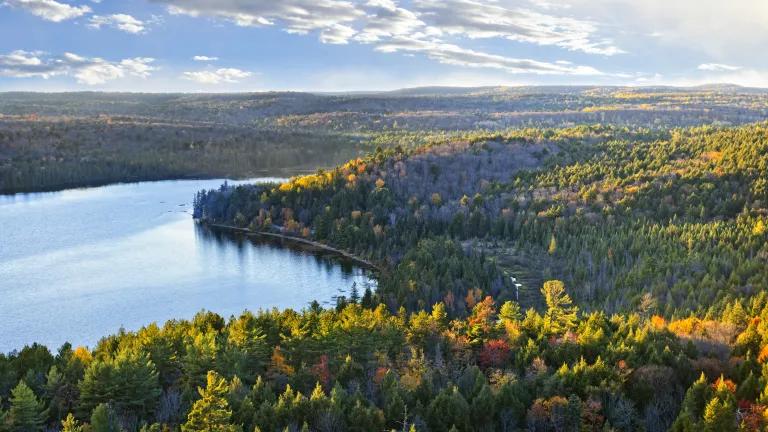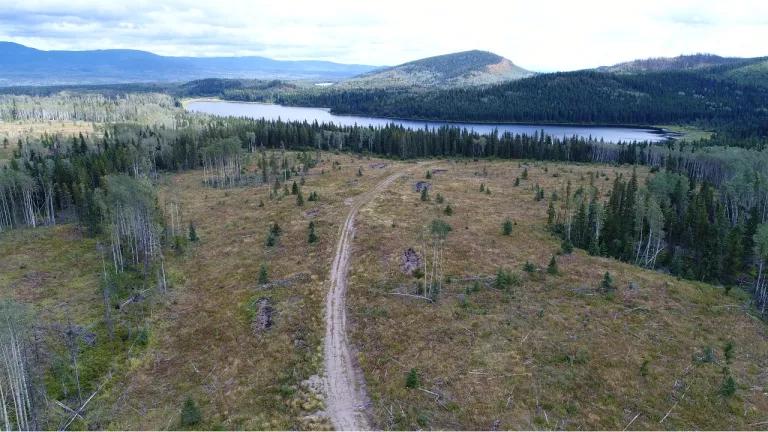The True Cost of Undervaluing Our Forests
As countries begin implementing the Glasgow Leaders’ Declaration on Forests and Land Use, success will depend on embracing a truly global framework that looks beyond forests’ utility.

Forests are defined by their interconnectedness. From latticework, lichen-strewn branches and rich brocades of roots, soils, and microbes, to the wondrous, hidden mycorrhizal “wood wide web,” forests are communities, a gestalt, that defies reduction to its constituent parts. As we celebrate International Day of Forests today, in these intricate ecologies, shaped and defined as much by the slow passage of time as by any organism, forests manifest untold value for the climate, biodiversity, and human health.
Perversely, global frameworks have largely valued forests as the sum of their trees rather than an ecological whole, prioritizing them as the source of a single extractable resource—logged wood. Particularly in the boreal and temperate forests of the Global North, where governments’ blind fidelity to industrial logging dominates how forests are viewed, regulated, and valued, “missing the forest for the trees” is exactly what countries have done, with catastrophic costs for our climate and biodiversity that we can no longer afford to ignore.
As countries begin implementing the Glasgow Leaders’ Declaration on Forests and Land Use, a commitment from over 140 countries to end and reverse forest loss and land degradation by 2030, success will depend on embracing a truly global framework that looks beyond forests’ utility as toilet paper and 2x4’s. It will depend on holding all governments, from the tropics to the boreal, accountable for recognizing, protecting, and enhancing forests’ unique and irreplaceable value.
Primary forests, which are forests that have never been industrially disturbed, have synergies and structures that come only after generations of growth, accumulation, and decay. These increasingly rare forests store 30-50% more carbon than previously logged forests and provide habitat to a unique array of biodiversity found nowhere else on earth. Their complexity makes them more resilient to the growing impacts of climate change and will similarly help communities globally adapt to a changing world.
Yet, in defiance of science and Indigenous knowledge, primary forests’ unique value—and the cost of their disappearance—is almost entirely invisible in international and domestic policy, which center how a forest is used by industry over its ecological importance.
Most egregiously, the term “deforestation” in international parlance doesn’t encompass the logging industry’s clearcutting of a forest. Instead, it narrowly applies only when the forest has been converted to another use entirely, like a farm or an urban development, not when a forest has been cut down but will, at least in theory, be allowed to regrow. That means that even a barren, stump-filled landscape still counts as a forest and that countries like Canada, which clearcuts over a million acres of boreal forest each year, can claim they have close to zero deforestation.
With the value of primary forests absent in international and domestic policy, so is the cost of their loss to the climate and biodiversity. Canada, like other countries in the Global North, is able to hide behind claims of “world-leading” sustainable logging practices while allowing the erosion of climate-critical primary boreal forest and opposing legislation in the U.S. that would help to protect these unique landscapes. Under this warped framework, Canada also appears increasingly poised to enable and sanction provinces’ prioritization of industrial logging over essential protections for threatened boreal caribou, which depend on primary forest habitat.
Countries’ forest carbon accounting practices are also obfuscating the climate cost of destroying primary and older forests. As an investigation from The Washington Post highlighted, countries have been underestimating their land use emissions by hundreds of millions of tons of carbon each year. In Canada alone, the government’s annual greenhouse gas inventory downplays logging’s annual emissions by more than 100 megatons of carbon dioxide each year, or more than 10% of Canada’s overall emissions, artificially portraying logging as carbon neutral.
The narrow focus on forests’ timber value also comes with significant economic opportunity costs. Forest protection has its own commercial value, providing opportunities for the growth of new sustainable sectors that depend on keeping forests standing. As Indigenous Peoples have shown through initiatives such as Indigenous Guardians programs and other Indigenous-led forest stewardship, forest protection holds its own prospects for both economic development and the advancement of Indigenous self-determination.
In addition, the marketplace is increasingly recognizing the value of primary forests and calling for products that don’t come at their expense. In 2020, 67% of Procter & Gamble’s shareholders, including financial giants like Vanguard, Blackrock, and State Street, voted in favor of a resolution requiring the company to report on steps it’s taking to address deforestation and primary forest degradation in its supply chains—the first successful forest-related shareholder resolution in history. New York legislators have introduced a procurement bill that would require state contractors to ensure there is no tropical or boreal deforestation or intact forest degradation or violations of Indigenous rights in their forest product supply chains. More and more tissue brands are embracing recycled content and alternative fibers over pulp from primary forests.
As the recent Intergovernmental Panel on Climate Change (IPCC) report urged, the world will need to embrace transformative solutions to avoid locking in an unthinkable climate future. For forests, that transformation needs to start with how governments view and value these richly interconnected ecosystems. In implementing the Glasgow Declaration, policymakers, particularly in the Global North, now have a chance to move beyond antiquated, dangerous conceptions of forests and implement policies that recognize forests’ value outside the lumber yard and pulp mill. Forests aren’t just internally interconnected—their fate is tethered to the future of people around the world.



